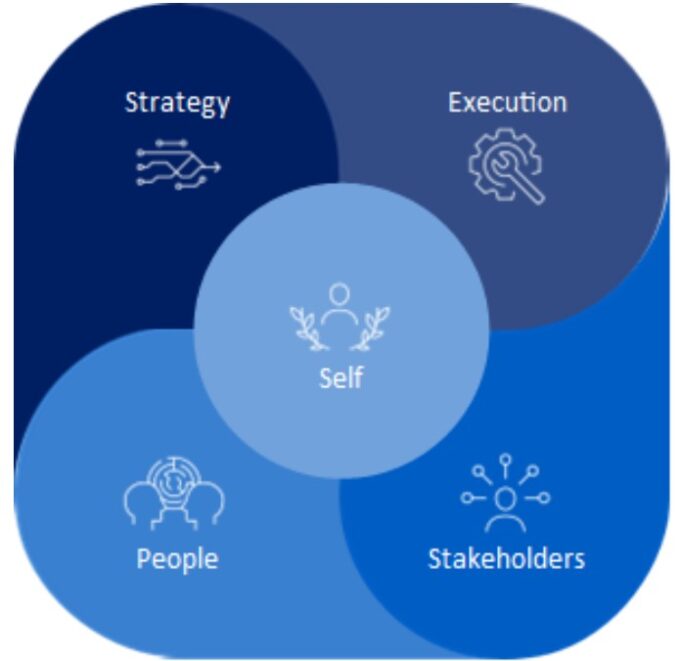Potential reads to help you become a better leader
Howard Yu, LEGO® Professor of Management and Innovation at IMD, recommends six books that will inspire you and help maximize your talent....
Audio available
19 February 2024 • by Tania Lennon in Videos
New approaches to modeling executive performance can help identify leaders with the skills to build future-ready businesses. ...
Organizations continue to face challenges in finding the talent they need to sustain success. Dynamic role requirements reduce the effectiveness of succession planning, where the very characteristics identified as the basis for progression become rapidly obsolete once the individual has arrived in the target role. With less time to prepare individuals to take on senior leadership roles, organizations need to be more precise about where to focus development.
So how do organizations accelerate talent development while ensuring they have equipped leaders to build future-ready businesses? And how can they identify the factors that will enable future success in senior roles when the roles themselves are changing so rapidly?
This is a focus of research I share with my colleagues Misiek Piskorski and Ric Roi. We explore and create innovative, technology-enabled approaches to assessment and career development that can help develop leaders who can quickly adapt and acquire the skills needed to address emerging challenges and opportunities in an ever-changing world.
The first step is to identify which skills are needed to keep ‘performing’ or improving the core existing business, while at the same time ‘transforming’ by identifying and developing opportunities for creating new revenue streams. This is known as ‘dual transformation’, and CEOs who excel at leading them tend to exhibit optimization and transformation behaviors across five domains of the leader role. By taking a holistic perspective across the key aspects of the leader role, we can make more specific recommendations on development and performance impact.

Faster, better, more in-depth talent assessments for a wider talent population may seem like seeking the Holy Grail but the application of new technology, including game-based assessments and the application of generative AI (GenAI) to assessments, can produce a better candidate experience and richer and more precise insights into leadership performance and potential as the basis for progression planning and career development.
Based on my research in assessment innovation, we have identified that new technology offers greater precision and deeper insight for three reasons. Firstly, it enables the collection of many more data points, which provide richer insights into key targets of interest. Secondly, it enables data collection of variables that are more dynamic and interdependent. For example, in our Future-Ready Assessment Suite, we integrate three aspects: what the individual wants to do (motivation), what they know how to do (business acumen), and what they choose to do (situational judgment). Thirdly, it collects better quality data, both because of the more engaging methods used and because people engage with these methods in a more natural and relaxed way.
By setting these in the context of the individual’s role challenges and career aspirations, we can provide robust, integrated recommendations for where the individual should focus their development for maximum impact on their current and future performance. The tools can also be loaded with a company’s competencies to ensure the assessment is as finely focused on the needs of the company and individual as possible.
IMD’s future-ready leader assessments measure the extent to which leaders are likely to draw on a range of behaviors across the five domains of the leader role. The broader the range of behaviors, the more likely leaders are to sustain success in a dynamic environment as they can better address the diverse and heterogeneous demands of the leader role. Only about 12% of leaders assessed by IMD Strategic Talent demonstrate the orientation to create value through both ‘performing’ and ‘transforming’ across the domains of the leader role.

“Some of a company’s highest potential leaders may be modestly hiding in plain sight.”
The future-ready assessments are underpinned by a model of executive behavior designed to pinpoint why an executive does or does not leverage a wide repertoire of behaviors. This model comprises the three underlying drivers of leadership behavior: motivation, know-how, and situational judgment. Priority opportunities to build a broader repertoire of leadership behaviors linked to business and role challenges and career aspirations are identified that specify which driver needs to be addressed. These become the basis for an Individual Development Plan (IDP) or a Leadership Development Plan (LDP). With this deeper insight and higher precision, the IDP can achieve both greater impact on performance and faster progression.
An important element of the development process is that candidates are ‘progressed’ rather than succeeding someone, which implies promotion. Progression also gives ample flexibility for the candidate to be developed in different dimensions, rather than only in a linear (promotion) direction. This widens the range of possibilities for development to ensure sufficient breadth of experience, which Roi’s research has shown to be directly correlated with leaders’ propensity to deploy both optimization and transformation behaviors.
Progression can take the form of offering candidates a more diverse range of experiences that enables them to round off their knowledge of how the business operates – for example, a move to a different business unit in the same role, a different functional responsibility, or a geographical move. Many leaders desire to progress quickly, moving up the career ladder through direct vertical promotions. While horizontal moves mean it will take more time to climb the ranks, it also means executives will be better equipped to succeed in the top jobs, which require a greater breadth of experience and a wider range of behaviors.
This is a hot topic amongst the leading international human resources leaders we are in touch with through our work. For many of these talent, learning, and HR leaders, a more diverse range of relevant experiences enables leaders to round off their knowledge of how the business operates. Helping leaders to understand that the longer-term payoff of development that broadens their experience can get buy-in from talent, as they see the commitment of the organization to their future career success.
Clearly articulating career aspirations and advocating for promotion can be a sign of self-confidence – but not all leadership contenders are extroverts who will push themselves forward. Some of a company’s highest potential leaders may be modestly hiding in plain sight. Robust data from innovative assessments can identify their latent or unseen behaviors and bring them to light, while human-centered progression keeps talent engaged.
Roi describes the case of an executive who was a high performer in his R&D leader role but had significantly more untapped potential that was not readily evident. “Our assessments showed that this leader had the strategic ability and transformative vision to take on CXO roles – but it took a deep dive into the data across three or four conversations with the executive team before they were prepared to consider it.” Yet today this ‘hidden gem’ has taken on a CEO role, following a track record of exceptional results across successive stretch roles, turbo-charged by the opportunities that the assessment and the personalized development plan unlocked for him.

Another scenario is ‘talent hoarding.’ Sometimes managers appreciate the value and contribution of their talent so much that they don’t want to share them and will therefore not propose them for development in other roles in the company. An unbiased assessment of competencies and behaviors can allow these hidden gems to become more visible to others, opening up new possibilities for the individual.
IMD’s Head of Impact, Johanna Leppävirta has developed approaches to demonstrate how to connect talent assessment and development to organizational performance. Some examples include looking at the extent to which individuals’ involvement improves processes and therefore increases productivity through contributing to measures to increase revenue, profitability, and speed, or to reduce costs and downtime.
These approaches have been incorporated into personalized talent development journeys. By crafting high-impact journeys with embedded measures to track progress and facilitate further personalization, organizations can achieve a higher impact on performance and a greater ROI on their investments in talent development.
According to Piskorski, precision personalized progression planning enables organizations to support leaders to address the immense demands that they face in business today. “As well as performing while transforming, leaders face a proliferation of responsibilities and expectations to capitalize on economic and market changes while managing in an unstable and evolving geopolitical world,” he said. “But these demands are being matched by innovative talent assessment and development strategies that can identify, assess, develop and sustain a pipeline of top talent for today and tomorrow.”

Executive Director of the Strategic Talent Development initiative
Tania Lennon leads the Strategic Talent team for IMD. She is an expert on future-ready talent development, including innovative assessment methods to maximize the impact of talent development on individual and organizational performance. Lennon is a “pracademic”, blending a strong research orientation with evidence-based practice in talent development and assessment.
18 October 2024 • by Howard H. Yu in Talent • 3 min read
Howard Yu, LEGO® Professor of Management and Innovation at IMD, recommends six books that will inspire you and help maximize your talent....
 Audio available
Audio available16 October 2024 • by Lara Carty in Talent • 8 min read
A deeper understanding of expertise has the potential to transform how you define, assess, and develop the talent your organization needs to excel. ...
 Audio available
Audio available15 October 2024 • by Robin de Haas in Talent • 7 min read
Pioneering vocal leadership coach Robin de Haas analyzes the breathing and speech patterns of US presidential candidates Kamala Harris and Donald Trump as evident in their recent debate and offers some sound...
4 October 2024 • by Michael Skapinker in Talent • 6 min read
Older workers have much to offer but don’t always get the chance to show it. Mixed-generation teams could help....
 Audio available
Audio available20 September 2024 • by Jerry Davis in Talent • 8 min read
Information technology can reduce the transaction costs of using markets. For labor markets, however, the costs have merely been transferred from business to workers....
 Audio available
Audio available18 September 2024 • by Peter Attfield in Talent • 6 min read
Organizations place too much emphasis on ‘high potential’ leadership talent at the expense of people who can deliver value in other ways....
 Audio available
Audio available13 September 2024 • by Tania Lennon, Misiek Piskorski in Talent • 10 min read
Long-trusted ways of leadership talent development are outmoded. Is it time for a radical rethink?...
 Audio available
Audio available11 September 2024 • by Sarena Lin , Tania Lennon in Talent • 7 min read
How leaders can retain cutting-edge expertise as the lifecycle of skills shrinks....
4 September 2024 • by Heather Cairns-Lee, Jasmina Djordjevic in Talent • 10 min read
In a world of AI, drawing on the untapped potential of the human capabilities of creativity and imagination is perhaps more important than ever for leaders....
27 June 2024 • by Tomoko Yokoi in Talent • 4 min read
Too many organizations assume late-career workers can’t keep up with new technology. In doing so, they are ignoring a hugely important labor pool....
Explore first person business intelligence from top minds curated for a global executive audience